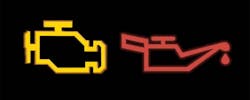Scheduled Maintenance Can Prevent Costly Engine Repairs
Timely vehicle maintenance makes good business sense, especially when compared to costly engine repairs or an engine replacement.
Extended service intervals have created a major concern for the old-school generation - especially technicians who have serviced vehicles for 30-plus years. Our early driving and maintenance experience encompassed less fuel efficient and higher emission output vehicles. We were accustomed to vehicles being serviced every 2,500 miles. It is a proven fact that the new technology has made the internal combustion engines more fuel efficient and less polluting. For the younger generation, the extended service intervals are normal. Without a warning indicator or maintenance required message, many would not give second thought to driving a vehicle 10,000 miles before having the oil and filter changed. When the service reminder light illuminates, they may continue operating the vehicle for an extended period of time before having the vehicle serviced. During this time, the oil filter bypass valve would most likely be open allowing contaminated oil to be pumped throughout the engine. Extended service intervals have certainly enhanced vehicle sales, as the new car dealers promote low maintenance as a plus for purchasing the vehicle. Some accept this marketing strategy while others question the extended service intervals and compromise on the mileage at which to have the lube service performed.
Identifying severe versus normal service is the key. Most think they drive under normal service conditions. Some vehicle manufacturers have made adjustments in their recommended service intervals because of contamination issues resulting in high warranty claims. This has been documented in factory service bulletins and letters to vehicle owners to have their vehicles returned to the dealer for a software update to increase the maintenance frequency.
Oil Life Monitor Update
High engine warranty claims have prompted GM to update the software for the oil life monitoring system, which will result in more frequent oil changes. Certain applications built prior to the production change will receive a software update from GM. Those applications include certain 2010-2011 Buick LaCrosse, 2011-2012 Buick Regal, 2010-2012 Chevrolet Equinox or GMC Terrain equipped with a 2.4L engine. This engine has been plagued with premature balance chain wear.GM Oil Life Monitor Operation Calculation
GM vehicles have been equipped with an oil life monitoring (OLM) system since 2010. According to GM, the system calculates the percent of oil life remaining through three pathways:- Engine revolutions: The oil life starts with a fixed number of engine revolutions and will decrease with each revolution. Cold and hot coolant temperature readings have multipliers that reduce the engine revolutions pathway quicker, depending on how far from the normal oil temperature the engine is operating. Note: If the coolant temperature gets above 260° F, the oil life will go to 0 percent.
- Mileage from last reset: Starting with the 2013 model year, the OLM is capped at 7,500 miles for all GM powertrains operating under normal service conditions, except the Volt. In perfect conditions, a vehicle would reach 7,500 miles from the last reset and the oil life left would be 0 percent. Based on driving conditions (severe service), the recommended service interval may be much less.
- Time: This function provides a fixed decrease in oil life for a given time once the OLM is reset. The oil life will drop to 0 percent after one year, regardless of the amount of engine revolutions or how many miles since the last reset. Exception: The Volt uses a two-year timer instead of the one-year, as well as the engine revolution counter. It does not use the mileage pathway to count down.
Nissan Service Interval
We just added a Nissan Murano to our fleet. The standard maintenance under normal and severe service calls for an oil and filter change every 5,000 miles or six months with the exception of flex fuel vehicles and taxi, which calls for service at 3,750 miles or three months. Most of our driving would qualify the vehicle under a taxi use category.Identifying Normal Versus Severe Service
When should the vehicle be serviced? There is a misconception when identifying vehicles being operated in severe or normal service conditions. Let's consider the difference:Normal service is a vehicle that is continuously driven on the highway at constant speeds. These operating conditions are easy on the lubricant, as the engine is operating efficiently.
Severe service is a category that many of your customers operate their vehicle in. Most are surprised to learn that their vehicle should be maintained at a severe service level. Let's consider some conditions that qualify the vehicle under severe service:
- Short-trip driven vehicles (five miles or less) promote an accumulation of sludge and other deposits due to the oil not reaching its normal operating temperature, which can burn off condensation and other contaminants. The engine is not operating efficiently, resulting in crankcase dilution.
- Vehicles driven during extreme hot weather conditions, especially in heavy traffic.
- Short-trip driven vehicles (10 miles or less) in ambient temperatures below freezing.
- Delivery vehicles, taxis or any slow-speed driving for long distances, such as that encountered during heavy traffic conditions, or vehicles that are allowed to idle for extended periods of time.
- Vehicles driven off-road in dusty conditions.
- Rough, muddy, sandy or salt spread road conditions.
- Driving continuously while exceeding normal highway speeds.
- Pulling a trailer, boat or camper.
- Frequent starts and stops.
Engine Sludge Voids Vehicle Manufacturer Warranties
Regular scheduled maintenance is necessary to prevent the formation of sludge build-up that can affect engine lubrication, which can promote engine or component failure. The formation of engine deposits and excessive warranty returns has resulted in some vehicle manufacturers adjusting their recommended maintenance service intervals, requiring a more frequent service. Neglecting scheduled maintenance may result in the vehicle manufacturer denying warranty coverage, in addition to reducing the performance, reliability and safety of a vehicle.GM states that engine damage resulting from sludge and contamination conditions will not be covered by the vehicle manufacturer's warranty. Following are some conditions resulting from improper maintenance and the formation of sludge:
- The oil filter element pleats become blocked due to an accumulation of sludge and debris.
- Sludge in the oil filter cap and filter housing. Splits, tears or improper installation - to include missing, torn or damaged seals/O-rings.
- Debris accumulated in the oil pan, blocking the pick-up tube (minor screen debris is acceptable).
- Valve cover breather ports or oil return ports blocked with sludge.
- Rocker arms and valve covers coated with sludge.
- Sludge accumulation on the camshaft and related hold-down caps.
- Camshaft actuator solenoids coated with sludge.
- Inoperative active fuel management valve lifters/solenoids due to sludge deposits (see Mighty Tech Tip No. 185 Low Oil Pressure Message…Locating the Mystery Filter).
- Air filter bypass due to a damaged housing/ducts or filter seal, promoting bearing and cylinder wall damage.
- Contamination due to the use of sanding disk to remove gasket material.
Maintenance costs are pennies on the dollar compared to the costs of mechanical failures due to poor lubrication resulting from improper maintenance. Some claim that their lubricant will last for a year, and I am certain their research will support that claim. The concern is how long will the filter last before going into bypass mode, resulting in unfiltered lubricant flowing to and through the vital engine components. Identify your customer's vehicle operating category and service accordingly. You will be surprised how many will require severe service maintenance.
About the Author

